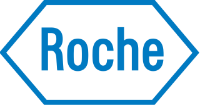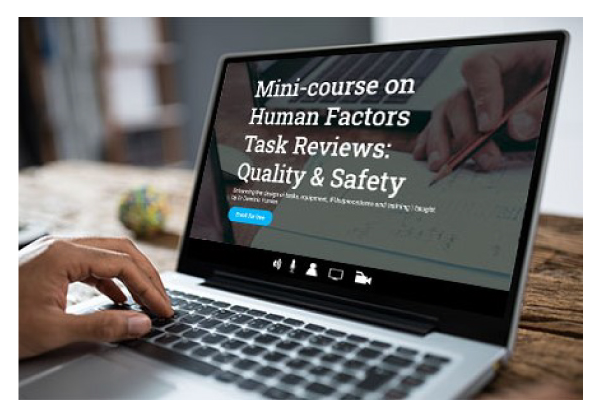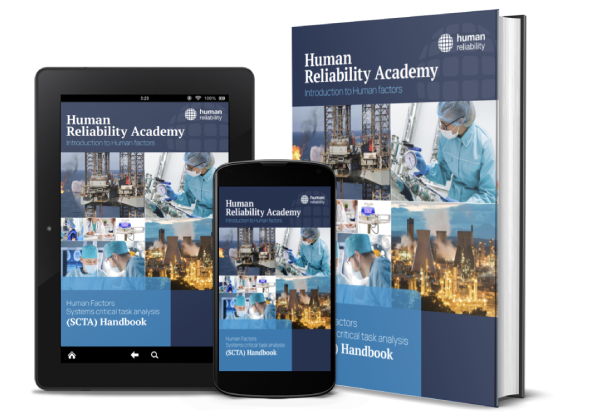Proactive Human Factors attends to vulnerabilities before incidents happen to reduce risks and improve protections for staff, processes and assets. However, it is not always obvious how to organise this.
We offer different management models for organising proactive Human Factors, that are applicable to Oil, Gas and Chemical, Pharmaceutical manufacture or medical device design, mining or manufacturing.
- Done-For-You (DFY)
- Do-It-Yourself (DIY)
- A) Centralised
- B) Distributed
We reflect on the pros, cons and suitability of these models for different contexts.
We’ll refer to this proactive approach as Human Factors Critical Task Review (HFCTR) throughout the article. This is also known as Safety Critical Task Analysis (SCTA) which is more common in the Process Industries. But this general methodology is also known as SHERPA (Systematic Human Error Reduction in Process Analysis).
REACTIVE TO PROACTIVE HUMAN FACTORS
Whether you’re part of an oil, gas or chemical company that is required to do Safety Critical Task Analysis (SCTA), a mining or manufacturing company looking for best practice, a pharmaceutical manufacture more interested in Human Performance and Quality Systems, or another organisation that is interested in Human Factors risks… it is not always obvious how to embed and organise proactive HFCTR.
More commonly there is a requirement to investigate incidents. So after something has happened the organisation and regulators will want to find and fix the cause to ensure it never happens again.
Here we want to turn our attention to proactive Human Factors and the management of risk. So assessing vulnerabilities and risks before anything has gone wrong. Arguably, there is a good opportunity to learn at this stage because organisation has not suffered a loss and individuals do not fear implicating themselves so can share information easily, and it makes financial sense because risk management is cheaper than having an accident.
When something has gone wrong it is more obvious where to focus attention – on whatever has gone wrong. However, where do you look when nothing has gone wrong yet?
CREATING A PROACTIVE HFCTR PROGRAMME (BRIEFLY)
There are two basic things you need to consider here:
- identifying tasks to put on your list, and
- prioritising that list.
We’ll keep this brief as it warrants its own blog or talk, but we need a way of selecting tasks that we want to look at. Generally we won’t have the resources to look at everything. So we want to look at the tasks that will be of most value to the organisation. These could be the tasks that expose the company to the greatest loss or risk.
High hazard sites will have engineering existing risk assessments that can be used as a starting point for task identification . For sites interested in quality it might be tasks that are critical to losing batches and downtime. Or it might be tasks that are new, have suffered near misses, or are of concern to managers and operators.
This list can then be reviewed and organised in order of priority. This could include thinking about the severity of consequence (is it high, medium or low consequence?), human involvement in the task (is this highly automated or a highly manual process), and some notion of vulnerability (is the task simple or complex, is it easy or difficult to do, etc.).
Once we have a HFCTR programme of work, i.e. an organised list of critical tasks that we want to work through, then how do we organise this?
3 MANAGEMENT MODELS FOR PROACTIVE HUMAN FACTORS
We outline three different management models for organising a proactive programme of HFCTR work. These could be adopted, adapted and mixed.
1. Done-For-You (DFY)
This is where organisations hire external consultants and expertise to do the Human Factors work. It is done for them.
A positive for this model is that organisations can start quickly without changing any internal structures, responsibilities and resources. Another benefit is bringing in outside help that is highly practised at this sort of work. This also helps to focus attention and motivate commitment (e.g. we’ve paid for these people to be here, so we need to make sure that we have the people they need to talk to be available).
You might also get better engagement and ownership of the work by staff if it is more deeply embedded in the organisation (see the other models). Also, a downside includes the expense of hiring external help, especially if there is an extensive programme of proactive work to conduct. This might not be an issue for a smaller programme of work.
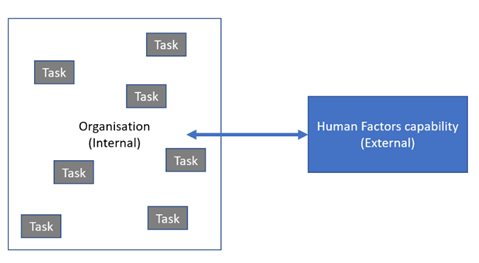
Suitability:
- Organisations that are just getting started and want to dip their toe in the water of Human Factors Critical Task Reviews (HFCTR).
- Organisations that don’t currently have Human Factors capability and need a short term fix, e.g. regulators are demanding they start a programme of HFCTR work in a relatively short time frame.
- Organisations that do not want to develop an internal Human Factors capability (yet).
- Organisations that want to learn more by observing others do this type of work.
HRA can help support this model through consultancy services like helping to develop and manage a programme of HFCTR work, and doing the individual task reviews.
HRA training can help support this model as it is always good to have someone internal to coordinate the work and act as an ‘intelligent customer’. HRA has had people attend training so they know what good HFCTR looks like, so they are in a better position to procure this type of work, have expectations and judge its quality.
2. Do-It-Yourself (DIY)
This is where organisations choose to have some internal capability to do the Human Factors work themselves. There are two different models within this:
· A) Centralised – Human Factors capability is focused on a few members of staff or department who leads the Human Factors work.
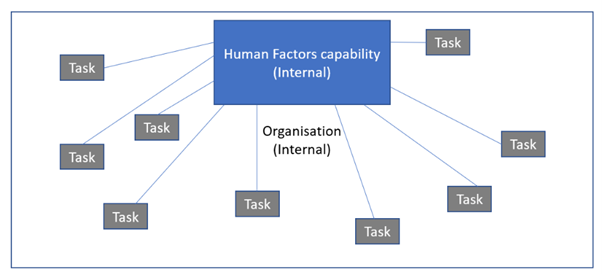
B) Distributed – Human Factors capability is strategically distributed around the organisation. On a large scale, if we’re thinking about multinationals the network might include a centralised unit and different leads at each site. At a site level there might be a coordinator with different Units and Departments that have their own responsibilities to conduct proactive Human Factors work.
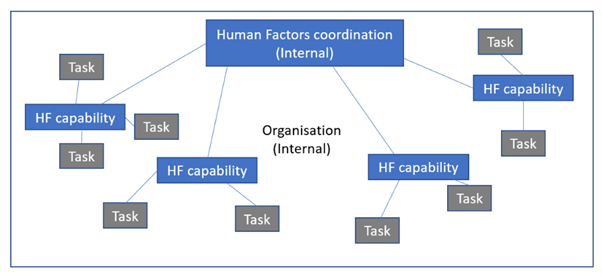
A positive for this model is that the site itself has more engagement and ownership over the Human Factors work. Internal people will have better access to the site and staff. As this internal capability is better embedded it is easier to take part in ongoing conversations about the application and growth of Human Factors work more broadly.
The more distributed this work and capability the more chance of leading to a cultural shift to support a systems view of human performance. Arguably, supervisors and operators will have the best knowledge of work-as-done and the associated risks.
Downsides include the Human Factors capability sometimes feeling isolated if they are on their own and sponsors may not have an appreciation of Human Factors and how learnings are gained. This can be alleviated by having more people trained in Human Factors, having an external Human Factors coach or mentor, or joining a group where challenges and ideas can be shared. Depending on the extent of the proactive programme of Human Factors work this internal resource might also find themselves being overwhelmed – a solution to this might be to get in external support (DFU) or getting more internal help by distributing the work.
Distributing the work further also comes with downsides as people need to be freed to do the work from their ordinary jobs, and the Human Factors expertise becomes diluted.
Suitability
- Organisations that have bought into having Human Factors capability and resource internally, rather than as an external bolt on to their work.
- Organisations that have an extensive and developing programme of Human Factors work.
- Organisations that want to move resource already committed elsewhere, e.g. to Quality Improvement work, incident investigation and deviation management, to a programme of proactive Human Factors work.
HRA can help through training Human Factors champions who will be a focal point for coordinating the work and the people who area expected to complete Human Factors activities. We can provide policy review and advice on how to organise this work. We can provide exemplars, resources, ongoing coaching and host a community of practice to maintain competence and problem solve as this programme of work is rolled out.
MIXING AND MATURING MODELS
There are various ways in which models can be mixed and adapted. For example, it is not a binary choice between DFU and DIY, instead it might be seen as a continuum with the potential for DFY evolving into DIY.
An organisation might undertake to do the majority of the task reviews themselves, but might buy in external help for particularly critical or complex tasks. This sort of help might have other collateral benefits as organisations can learn from their externally supported projects, reflecting on different ways of organising things, and evolve their own Human Factors practices.
An organisation might also move through the models. For example, starting with an acute need they might get in external support for some proactive Human Factors work (DFU). After this, they may attend training and invest in doing this themselves (DIY that is centralised). They may then reflect on a broader roll out of this proactive work and want to explore the potential benefits of embedding this within the organisation more deeply (DIY that is distributed).
HRA HELP
Human Reliability has been supporting clients across many sectors with this work for decades. Throughout the article we have listed ways that we can help with the different models. These include:
- Providing basic training in proactive Human Factors
- Providing advanced training in HFCTR
- Providing consultancy services to identify and prioritise tasks for a programme of HFCTR work
- Providing consultancy services for individual tasks that require HFCTR
- Providing review and support in developing policies to organise this work
- Providing mentoring and coaching to help individual HFCTR facilitators as they embed this work in practice
- Hosting a community of practice and group coaching as they embed this work in practice
- Providing the right tools, templates and processes to get this work done efficiently and effectively
FREE RESOURCES
If you’re new to Human Factors or Human Factors Critical Task Review (HFCTR) more broadly, then check out our FREE 30min mini-course on the subject: https://the.humanreliabilityacademy.com/courses/mini-course-on-hfctr
If you’re more familiar with HFCTR and Safety Critical Task Analysis (SCTA) and interested in how to organise this methodology well, with the right tools, templates and processes than check out this presentation for HAZARDS 30: https://www.humanreliability.com/blog/scta-reflective-practice/
Here is a link to our flagship SCTA course for Process Industries: https://the.humanreliabilityacademy.com/courses/human-factors-SCTA


